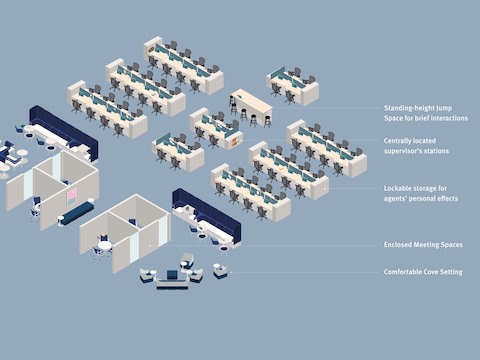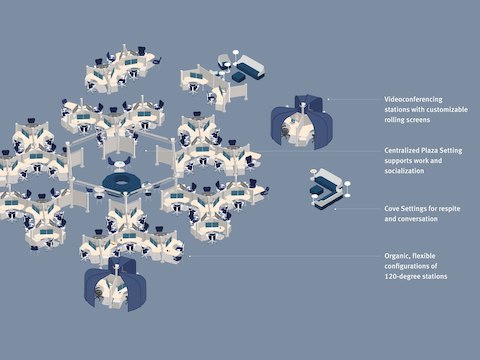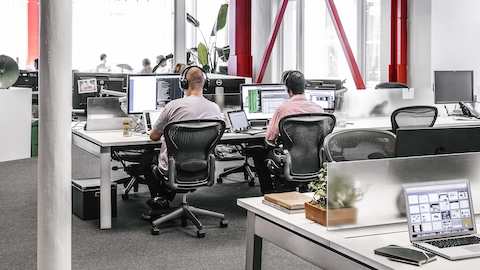People-Focused Contact Centers
People-focused contact center designs create better experiences for service agents and their customers.
Download PDF (1.14 MB)
Key Insights
- Organizations are investing in contact centers and talent that can handle increasingly complex and essential customer interactions.
- Research indicates that agent satisfaction and continuous learning ultimately improve the customer experience.
- We help organizations create contact center environments that offer choice, facilitate interaction, and address physical and cognitive ergonomics to improve agent comfort and performance.
“Convinced that customer experience drives customer choice, global businesses are investing in contact centers that focus on customer needs and preferences.”1
Keeping pace with ever-growing consumer demand for an effective and effortless service experience, spending on global contact centers reached $310 billion in 2016. In the US alone, the number of people employed in the industry grew by 21.8 percent over the past five years to over 2.3 million.2
Today’s organizations must support the many ways customers now expect to interact with them—email, web chat, social media, self-service channels, and video chat—in addition to telephone communication. The traditional business model is quickly changing, evolving from “call” centers to “contact” centers. Business leaders are investing in new technologies and in hiring and supporting high-quality talent to handle increasingly complex interactions.
As a result, decision makers are using the physical design of their facilities as a strategic tool to improve attraction and retention by enhancing the employee experience and supporting the interactive learning that ultimately improves customer focus. A well-planned contact center can lead to higher employee morale and more knowledge sharing, creating a positive work environment that carries through to improved service levels.
Based on research and a deep understanding of fundamental human needs,3 Herman Miller’s Living Office offers a variety of work settings that provide physical and cognitive support for today’s contact center agents and supervisors. When organizations and their design partners create and outfit these settings in alignment with their unique business goals, character, and activities, the result is flexible, people-focused contact centers that support learning, enhance the work experience, and—ultimately—improve customer experience.
Choice and Control
Contact center agents are often the first point of contact with customers. An organization’s reputation may ride on a single experience with a service representative. Yet the work can be stressful, and turnover rates are high; on average, contact center agents remain in their positions for just 3.3 years.4
Turnover is costly. When experienced agents leave, organizations lose valuable resources and must invest in training new ones. Recent estimates suggest that contact centers spend $10,000 to $15,000 to replace a frontline employee.5 The “soft costs” of losing a knowledgeable agent (technological proficiency, product familiarity, brand awareness, loyalty) are harder to measure but almost certainly higher. It’s no surprise that a recent survey of contact center leaders found that “attrition” was cited as the number one challenge facing contact centers.6
Attrition has proved to be a difficult problem to solve given the high stress levels associated with the job. In addition to “dealing with angry customers,” the research highlights “repetitive job activities, cognitive demands, increased time pressure, workload, decreased autonomy and performance monitoring” as stressors affecting agents.7
Herman Miller’s research and experience with designing contact centers suggest that work environments designed to support basic human needs for perceived autonomy8 and a sense of purpose9 can help to reduce stress and improve engagement for people working on the front lines of consumer contact.
In a job that offers little control over the pace of work and often requires employees to use scripted language and adhere to predetermined resolution structures, workplace design that offers choice can make a big difference in stress levels and overall well-being. “Contact center leaders are learning that offering a greater mix of workspaces can enhance the employee experience,” reports Tadd Wisinski, Co-Lead of Jones Lang LaSalle’s Contact Centers group.10
Mobile technology and sophisticated wireless headsets have enabled some contact centers to set their agents free in open work environments that let people choose from a variety of settings over the course of their work shift. Airbnb’s new customer experience hub in Portland, Oregon, offers lounges, shared tables, sheltered desks, and “duck-ins”—felt-lined nooks where agents can quickly find privacy—located throughout the office landscape.11 Managers of another center created a “Serenity Room” where agents can go to “unwind after a particularly stressful call.”12
Contact Center design can offer choice and control by providing access to private Haven Settings (located throughout the space) where agents can retreat to make a personal phone call or briefly unwind, and collaborative Cove Settings (placed near the Hive settings where most of the work takes place) where agents and supervisors can meet to quickly confer on customer questions or needs without disrupting team members. Furnishings, like sit-to-stand tables, that allow a choice of work posture and moveable screens that can be adjusted to block glare or mute distraction provide a sense of autonomy (and improve the quality of the connection between agent and customer). The ability to make even small adjustments, like adjusting a monitor or turning on a task light, can effect a major difference in perception of control.

Quiet Haven Settings give agents places to retreat and unwind during breaks.
Socializing and Sharing
According to Deloitte’s latest Global Contact Center Survey, “The quality of contact center talent will likely take on greater importance in the face of increasingly complicated subject matter and growing channels and technology tools. All respondents say they will be investing in talent improvement programs in the next two years.” Expanding training programs (63 percent) and deploying “flexible work arrangements” (53 percent) were listed among the talent-related initiatives they plan to undertake.13
Communication and sharing of knowledge among coworkers is increasingly essential to contact center performance and agent engagement. The recently released Gallup study “State of the American Workplace” found that, in contrast to workers in other industries, service and support workers experience a significant decrease in “active engagement” when they work remotely. The authors note: “The amount of time employees spend in the office influences their connection to other people and the company, and for employees serving others, this need is magnified.”14
Agents rely on each other, as well as their supervisors, for ideas and guidance that will enable them to respond quickly and effectively to customer questions and demands. Having a socially supportive environment that promotes knowledge sharing through collaboration with colleagues and supervisors and provides appropriate settings for formal and informal training can have a significant impact on both agent and customer satisfaction.

In a casual Cove Setting, agents and supervisors confer without disrupting the work of other team members.
For example, one recent study of contact center workers found a significant correlation between the amount of face-to-face interaction among team members and overall performance, measured as “calls per hour.”15 An earlier and often-cited MIT study measured improved performance when everyone on the same contact center team took their breaks at the same time.16
In addition to Meeting Space and Forum Settings designed for regular team meetings and formal training sessions, contact centers can offer informal settings for socializing during breaks, gathering for team celebrations, and brief one-on-one huddles with a coworker. A centrally located Plaza can serve all these functions and more by providing a place where the entire contact center team can congregate for announcements and social events, individuals can get to know each other and swap stories over lunch, or an agent and supervisor can have a quick conversation over coffee.
Workplaces can be designed to promote opportunities for helpful connection by paying careful attention to lines of sight, so agents and supervisors can easily see when assistance is required and available. Providing supportive furnishings, like guest seating, enables convenient and comfortable interaction. And Jump Space and Cove Settings that provide space for informal collaboration can promote learning and sharing of best practices—essential for improving the quality and effectiveness of customer experiences.
Comfort and Ergonomics
The restrictive and repetitive nature of their tasks and requirements to remain seated and take breaks only when scheduled make the contact center agent’s job physically demanding. As a result, these workers “have been found to experience eyesight difficulties, occupational voice loss, sleeplessness, back and neck pain, postural problems as well as headaches.”17
In addition, as the work becomes more technologically complex and agents are under pressure to respond to more complicated customer issues in increasingly personalized, customer-friendly ways, cognitive and emotional demands also take a toll on health and well-being.18 Ergonomic workplace designs that address these pressures not only reduce agents’ susceptibility to physical injury and discomfort, but improve motivation, focus, and concentration on the job.
Since contact center agents often share their workstations with colleagues on other shifts, furnishings that can be easily adjusted to support individual comfort and active work postures are essential. Equally important is providing clear and easy-to-understand information on healthful ergonomics at work, as well as training in how to make proper adjustments. In addition to high-performance task chairs that adjust for seat height, armrest height, and angle of recline, adjustable work surfaces and monitor arms help agents align their work area with their bodies and preferences.
Many contact centers are investing in sit-to-stand tables that allow agents to transition between sitting and standing throughout the day. Studies in which these tables are deployed have measured reduced upper-back and neck pain and improved mood states among formerly sedentary workers.19 One study in a contact center found that agents using adjustable sit-to-stand desks were more productive than those with non-height-adjustable desks.20
With more centers using video chat to communicate with customers, adjustments that give agents some control over lighting, glare, background views, and ambient sound can improve the quality of connection and interaction. Movable screens offer a level of visual and audio control and permit brief but refreshing views across the office landscape or out windows to the outdoors.
Issues of density and control over personal space can affect psychological comfort and cognitive performance. While space-efficient Hive Settings have the benefit of opening sight lines and improving communication among agents and between agents and supervisors, they must be carefully planned to ensure that workers don’t feel crowded or overly constrained. Workstations that are open to natural light and long views and provide some sense of enclosure and privacy are a difficult but achievable standard.
Years of research and experience have confirmed that clusters of workstations based on angles of 120 degrees not only make highly efficient use of space, but also are perceived by the people who work in them to be more spacious and comfortable than workstations based on 90-degree angles. When these organically shaped clusters are carefully placed in the office landscape and equipped with adjustable furnishings and screens, agents can interact comfortably—with their technology and with each other.
Fresh Takes on Contact Center Design
Herman Miller’s extensive portfolio of furnishings can be combined in a variety of ways to create supportive and inviting contact centers. From fresh takes on sit-to-stand benching solutions to innovative and space-efficient 120-degree planning options, these work environments offer choice, facilitate interaction, and address physical and cognitive ergonomics.
Renew Link sit-to-stand benches, for example, incorporate screens, angled surfaces, and an offset orientation to create physically supportive workstations that also address cognitive ergonomics by eliminating the discomfort and distraction that can result when people are located directly across from each other.
Space-efficient benching configurations can be complemented with enclosed Meeting Space Settings for agent/supervisor team meetings, open Cove Settings with soft seating for casual conversations and respite, and a Jump Space where agents can touch down to talk with colleagues.

Space-efficient sit-to-stand benching configurations complement settings where private conversations happen as naturally as casual interactions.
Many of our forward-thinking customers use the Resolve system as the foundation of their contact center design. A concise kit of parts comprising vertical poles with customizable screens attached at 120-degree angles, along with purposeful interior components that keep technology and other work tools within easy reach, Resolve creates calming, natural-feeling work environments where people feel valued and connected—not crowded or confined.
Interconnected Hive Settings clustered around poles equipped with Resolve’s 10-wire, 6-circuit power system effectively support dual monitors and other technology. Screens angled at 120 degrees and boomerang-shaped surfaces create comfortable, cockpit-like work environments for high-caliber agents. Separate clusters outfitted with rolling screens offer videoconferencing agents a level of visual and audio control and provide a backdrop that can be customized with the organization’s logo or other branding.
Resolve components can also be used to create a centrally located Plaza where agents can gather and socialize on breaks or meet for quick conversations with supervisors over coffee. Screens paired with groupings of tables and soft seating offer respite and a comfortable place for informal connection and collaboration.

Resolve in a 120-degree configuration forms flexible stations where agents feel connected—but not crowded or confined.
Notes
1. Deloitte, 2017 Contact Center Survey, (2017): 12, accessed August 23, 2017, https://www2.deloitte.com/us/en/pages/operations/articles/global-contact-center-survey.html.
2. JLL, “Why the Contact Center Industry Is Calling the U.S. Home,” (April 26, 2017): accessed August 11, 2017 http://www.jllrealviews.com/industries/why-the-us-contact-center-industry-is-calling-home/html.
3. Through research, Herman Miller identified six fundamental needs that all people share—security, autonomy, belonging, achievement, status, and purpose.
4. ContactBabel, “The 2016 US Contact Center Decision-Makers’ Guide,” accessed August 15, 2017, http://www.contactbabel.com/pdfs/july16/The-2016-US-Contact-Center-Decision-Makers-Guide.pdf.
5. Penny Reynolds, “Exploring Call Center Turnover Numbers,” Quality Assurance and Training Connection, (Winter 2015), accessed August 16, 2017, http://www.qatc.org/winter-2015-connection/exploring-call-center-turnover-numbers/html.
6. Lori Bocklund, “Contact Center Challenges and Priorities for 2017,” Contact Center Pipeline, (January 2017), accessed August 16, 2017, https://blog.contactcenterpipeline.com/2017/01/contact-center-pipeline-magazine-inside-our-january-2017-issue/pdf.
7. Monica Molino et al., “Inbound Call Centers and Emotional Dissonance in the Job Demands—Resources Model,” Frontiers in Psychology 7 (2016): published online July 28, 2016, https://www.frontiersin.org/articles/10.3389/fpsyg.2016.01133/full.
8. Herman Miller, “Autonomy at Work,” 2017.
9. Herman Miller, “Purpose at Work,” 2016.
10. Jones Lang LaSalle, “Why the Contact Center Industry Is Calling the U.S. Home,” (April 26, 2017): accessed August 11, 2017 http://www.jllrealviews.com/industries/why-the-us-contact-center-industry-is-calling-home/html.
11. Zachary Edelson, “Airbnb’s Portland Office Reinvents the Call Center,” Metropolis, January 9, 2015. Accessed August 16, 2017, http://www.metropolismag.com/architecture/workplace-architecture/airbnbs-portland-office-reinvents-the-call-center/html.
12. Paul Stockford, “Power to the People!” Contact Center Pipeline, February 2017, accessed August 16, 2017, http://www.saddletreeresearch.com/contact-center-pipeline-column/power-to-the-people.html.
13. Peggy Reynolds, “Exploring Call Center Turnover Numbers,” Quality Assurance and Training Connection, (Winter 2015), accessed August 16, 2017, http://www.qatc.org/winter-2015-connection/exploring-call-center-turnover-numbers/html.
14. Lori Bocklund, “Contact Center Challenges and Priorities for 2017,” Contact Center Pipeline, (January 2017), accessed August 16, 2017, https://blog.contactcenterpipeline.com/2017/01/contact-center-pipeline-magazine-inside-our-january-2017-issue/pdf.
15. Monica Molino et al., “Inbound Call Centers and Emotional Dissonance in the Job Demands—Resources Model,” Frontiers in Psychology 7 (2016): published online July 28, 2016, https://www.frontiersin.org/articles/10.3389/fpsyg.2016.01133/full.
16. Herman Miller, “Autonomy at Work,” 2017.
17. Herman Miller, “Purpose at Work,” 2016.
18. Jones Lang LaSalle, “Why the Contact Center Industry Is Calling the U.S. Home,” (April 26, 2017): accessed August 11, 2017 http://www.jllrealviews.com/industries/why-the-us-contact-center-industry-is-calling-home/html.
19. Zachary Edelson, “Airbnb’s Portland Office Reinvents the Call Center,” Metropolis, January 9, 2015. Accessed August 16, 2017, http://www.metropolismag.com/architecture/workplace-architecture/airbnbs-portland-office-reinvents-the-call-center/html.
20. Paul Stockford, “Power to the People!” Contact Center Pipeline, February 2017, accessed August 16, 2017, http://www.saddletreeresearch.com/contact-center-pipeline-column/power-to-the-people.html.
